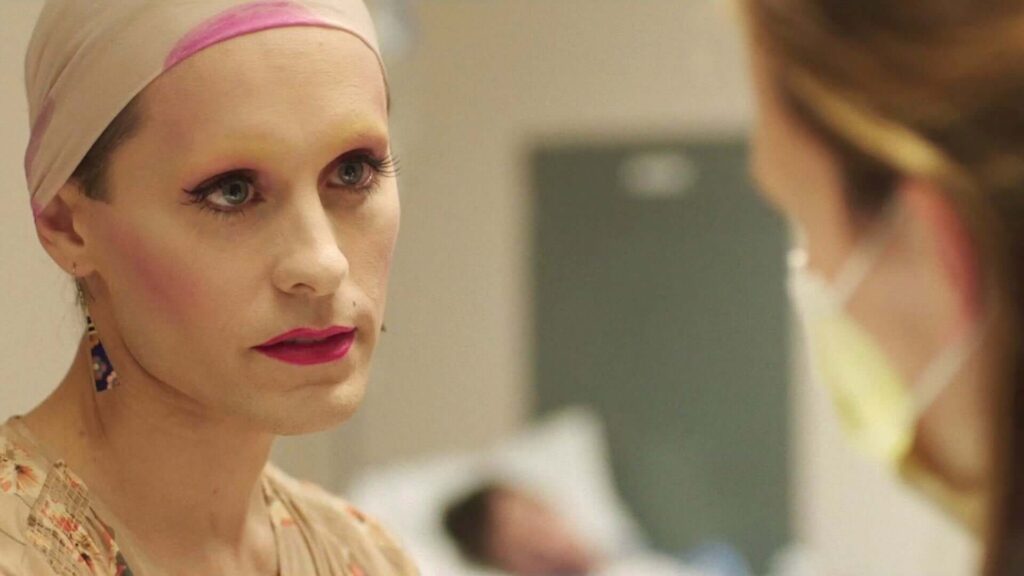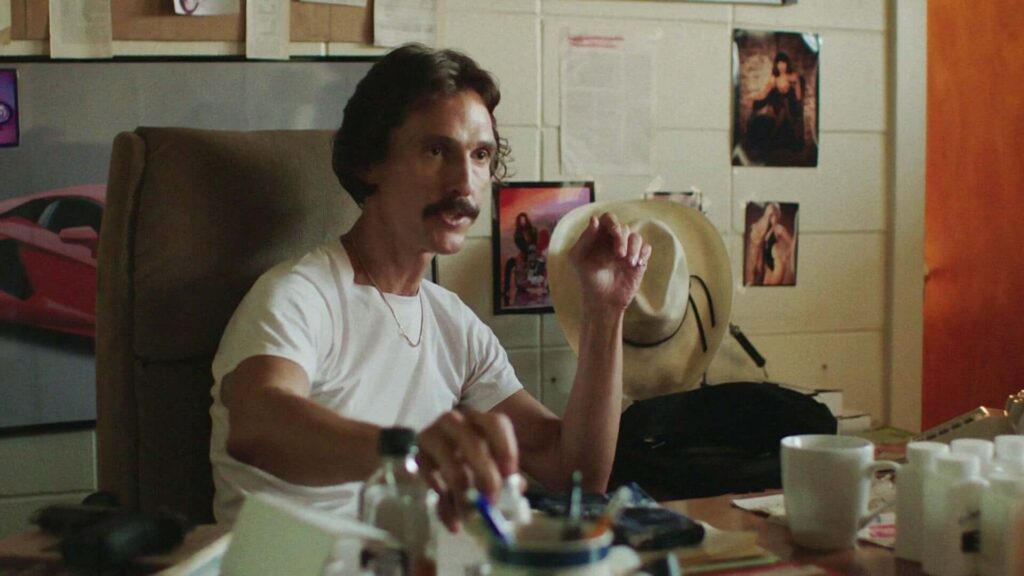Dallas Buyers Club

R, 2013, Drama/Biography, 1h 57m
Table of Contents
What Is Dallas Buyers Club About?
A rodeo cowboy is diagnosed with AIDS and begins smuggling unapproved drugs to help himself and others.
Why You Should Watch Dallas Buyers Club
Dallas Buyers Club is a powerful and emotionally charged film that tells the story of Ron Woodroof, a rodeo cowboy and electrician who is diagnosed with AIDS in the mid-1980s. The film follows Ron’s journey as he battles the disease and fights against the healthcare system to gain access to life-saving treatments.
One of the strengths of the film is its portrayal of Ron as a complex and flawed character. Matthew McConaughey delivers a stunning performance as Ron, capturing both his stubbornness and his vulnerability in equal measure. As the film progresses, we see Ron transform from a hard-drinking, homophobic cowboy to a compassionate advocate for those living with AIDS, and McConaughey’s nuanced performance is a major reason why this transformation feels so authentic.
Another standout performance in the film comes from Jared Leto, who plays Rayon, a transgender woman living with AIDS who befriends Ron. Leto’s portrayal of Rayon is both heartbreaking and inspiring, and his chemistry with McConaughey is one of the film’s greatest strengths. Together, they make an unlikely but powerful duo, challenging one another’s prejudices and working together to create the Dallas Buyers Club, a network for distributing life-saving medications.

In addition to the strong performances, Dallas Buyers Club is also notable for its portrayal of the healthcare system and the challenges faced by those living with AIDS during the early years of the epidemic. The film does not shy away from the harsh realities of this time period, including the lack of effective treatments and the pervasive discrimination faced by those living with the disease. However, it also shows the resilience and determination of the human spirit, and the ways in which individuals can come together to effect change.
Visually, the film is both gritty and intimate, capturing the mood and atmosphere of 1980s Texas with authenticity and attention to detail. The cinematography and production design are both top-notch, and the film’s use of music is effective in setting the tone and capturing the emotions of the characters.
Dallas Buyers Club is a powerful and moving film that offers an unflinching look at the challenges faced by those living with AIDS during a difficult and uncertain time in history. With strong performances, compelling storytelling, and a message of hope and resilience, the film is a testament to the strength of the human spirit and the power of compassion to overcome even the greatest of obstacles.

The Theme of Dallas Buyers Club
One of the main themes of the film is the fight for access to healthcare. Ron quickly realizes that the FDA-approved drugs available to him are toxic and ineffective, and that there are alternative treatments available overseas that could potentially save his life. However, these treatments are illegal in the United States and difficult to obtain. Ron’s determination to access these treatments, and his subsequent creation of the Dallas Buyers Club to distribute them to others, highlights the ways in which the healthcare system can often fail those who need it most.
Another important theme in the film is the struggle for acceptance and dignity. Ron faces discrimination and hostility from many people after his diagnosis, including his own friends and family members. However, his friendship with Rayon, a transgender woman also living with AIDS, shows how compassion and acceptance can break down barriers and foster meaningful connections between people from different backgrounds.

The film also addresses issues of addiction and personal responsibility. Ron’s drug and alcohol use initially contributes to his illness, but he eventually realizes that he must take responsibility for his own health and make difficult changes in his life if he wants to survive. His journey towards sobriety and self-acceptance is one of the most powerful and moving aspects of the film.
A final theme Dallas Buyers Club explores the nature of human connection and the importance of living life on one’s own terms. Ron’s determination to live his life to the fullest, even in the face of overwhelming adversity, inspires those around him to do the same. His legacy, as depicted in the film, is one of courage, compassion, and a fierce commitment to justice and human dignity.

The Cinematography of Dallas Buyers Club
The cinematography of Dallas Buyers Club is characterized by a gritty and raw aesthetic that reflects the harsh realities of life with AIDS in the 1980s. The film was shot on 16mm film, which gives it a grainy, almost documentary-like look. The use of handheld cameras and natural lighting further adds to the film’s realism, making it feel like you are a part of the story and experiencing the events firsthand.
The color palette of the film is also notable, with a muted, desaturated look that reflects the bleakness of the characters’ lives. However, there are occasional moments of brightness and warmth, particularly in scenes featuring the character Rayon, which serve as a contrast to the overall tone of the film.
The film’s use of close-ups is also significant, particularly in the scenes featuring the character Ron Woodroof, played by Matthew McConaughey. These close-ups help to emphasize the physical deterioration of Ron’s body as he struggles with the effects of AIDS. They also highlight the emotional turmoil he experiences as he grapples with his own mortality and fights to make a difference in the lives of other AIDS patients.

The Soundtrack of Dallas Buyers Club
The soundtrack to Dallas Buyers Club features a mix of songs from the 1980s as well as original music composed by Canadian artist Owen Pallett. The music plays an important role in setting the film’s tone and creating an emotional connection with the audience.
- “The Walker” by Fitz and The Tantrums
- “Shudder to Think” by Tegan and Sara
- “Life Is Strange” by T. Rex
- “Main Man” by Portugal. The Man
- “Sweet Thang” by Shuggie Otis
- “Dream Baby Dream” by Suicide
- “I Want to Be a Cowboy’s Sweetheart” by Patsy Montana & The Prairie Ramblers
- “Aids” by Tera Melos
These songs are all used to great effect in the film, helping to set the tone and capture the spirit of the era. Whether it’s the infectious energy of “The Walker” or the haunting beauty of “Dream Baby Dream,” the music plays a crucial role in making “Dallas Buyers Club” the powerful and memorable film that it is.
In addition to the licensed songs, Owen Pallett’s original score also adds to the film’s emotional impact. Pallett’s music features a mix of acoustic and electronic elements, and is characterized by haunting melodies and moody, atmospheric textures. The score is particularly effective in the film’s quieter, more introspective moments, such as when Ron reflects on his life and his mortality.
You can listen to music and inspired by the motion picture below.
The Cast of Dallas Buyers Club
- Matthew McConaughey as Ron Woodroof – a rodeo cowboy and electrician who is diagnosed with AIDS in the 1980s. He becomes an advocate for AIDS patients and starts smuggling unapproved drugs into the US to help them.
- Jennifer Garner as Dr. Eve Saks – a compassionate and dedicated doctor who treats AIDS patients at a Dallas hospital. She becomes an ally of Ron and helps him to obtain the drugs he needs to treat his condition.
- Jared Leto as Rayon – a transgender woman who befriends Ron in the hospital. She becomes his business partner in the Dallas Buyers Club, which sells unapproved drugs to AIDS patients.
- Steve Zahn as Tucker – a friend of Ron’s who helps him to smuggle drugs into the US.
- Denis O’Hare as Dr. Sevard – a doctor who disapproves of Ron’s unorthodox methods of treating his AIDS.
- Griffin Dunne as Dr. Vass – a doctor in Mexico who supplies Ron with the drugs he needs to treat his AIDS.

The Filmmakers of Dallas Buyers Club
- Jean-Marc Vallée: Vallée directed the film and is known for his work on films such as “C.R.A.Z.Y.” and “Wild.”
- Craig Borten: Borten co-wrote the screenplay for the film with Melisa Wallack. He had been working on the project for over a decade and based the story on real-life events.
- Rachel Winter: Winter served as a producer on the film and was instrumental in getting it made. She had previously worked on films such as “The Cooler” and “Dallas 362.”
- Robbie Brenner: Brenner also served as a producer on the film and was responsible for assembling the cast and crew. She had previously produced films such as “The Fighter” and “Dear John.”

Steak Fajita Pasta

Inspiration
“Relax, Smell The Steak” – Ron Woodroof

More About Dallas Buyers Club
“Dallas Buyers Club” received significant recognition and numerous nominations from prestigious awards institutions upon its release in 2013. It was particularly noted for its powerful performances and important storytelling.
At the 86th Academy Awards in 2014, the film received six nominations and won three:
- Best Actor: Matthew McConaughey won for his portrayal of Ron Woodroof.
Matthew McConaughey underwent a dramatic physical transformation for his role as Ron Woodroof in “Dallas Buyers Club,” losing approximately 50 pounds (22.7 kg) from his already slim frame through a strict diet and exercise regimen. His weight loss was a key aspect of his portrayal of Woodroof, who was emaciated and weakened by AIDS in the later stages of the disease.
He worked closely with a nutritionist and trainer to achieve his goal weight, which involved eating very small portions of food and doing intense cardio workouts. McConaughey has described the weight loss process as difficult and challenging, but he felt that it was necessary to fully embody the character of Woodroof and portray him accurately on screen.
- Best Supporting Actor: Jared Leto won for his portrayal of Rayon, a transgender woman.
- Best Makeup and Hairstyling: Adruitha Lee and Robin Mathews won for their work on the film.
- The film was also nominated for Best Picture, Best Original Screenplay (Craig Borten and Melisa Wallack), and Best Film Editing (John Mac McMurphy and Martin Pensa).
- Dallas Buyers Club was also recognized at the Golden Globe Awards. Matthew McConaughey won the award for Best Actor in a Motion Picture – Drama, and Jared Leto won for Best Supporting Actor – Motion Picture.
In addition, the film received numerous nominations from other awards institutions including the Screen Actors Guild Awards, the BAFTA Awards, and the Critics’ Choice Movie Awards, among others. These nominations and awards underscored the film’s impact and the powerful performances of its cast.
Dallas Buyers Club is based on a true story. The film tells the story of Ron Woodroof, a Texas electrician and rodeo cowboy who was diagnosed with AIDS in the mid-1980s and began smuggling and selling alternative drugs to other patients with the disease. Woodroof was a real person and his story, although fictionalized to some degree, is based on his actual experiences.

